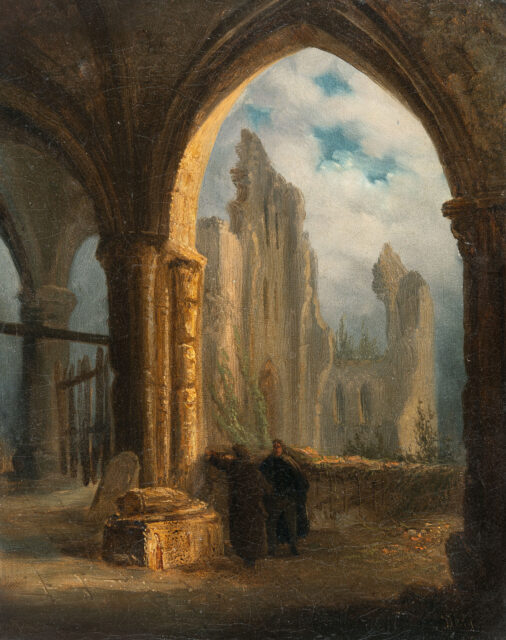Ruins of a Gothic church with a tomb
Details
Provenance: Private property, Berlin.
Description
Carl Blechen had already begun working as a painter before he entered Peter Ludwig Lütke’s landscape class at the Berlin Academy in the autumn of 1822. In his CV, written on the occasion of his election as a member of the Berlin Academy in 1835, Blechen writes that “all his leisure hours were filled with exercises in drawing, but of course they were as can happen without thorough instructions. The inclination became more and more active, and with no prospect of being able to make a fortune as a banker without speculative funds in the field that he unfortunately lacked, he finally took the decision to change career and to devote himself entirely to art.” These early, Pre-academic works include drawings and small oil paintings with romantic motifs of medieval ruins, with a certain longing for the past. The present small, newly surfaced painting also comes from this group and can help us understand Blechen’s development as a painter like no other work. From the vault of an early Gothic religious building – presumably some kind of cloister – our view falls upon a ruin that rises against a cloudy sky. Some bushes are starting to take over the ruins, reinforcing the impression of romantic abandonment like the two figures standing in the cloister who seem to ponder the tomb beside them. They are certainly monks, but Blechen leaves this unclear, just as it is impossible to gain a complete view of what we are seeing from the remains of the ruins. The entire composition has a sense of trying and searching about it, a quality that was described in a similar way by Ernst Heinrich Toelken, secretary of the Berlin Academy, in his memorial speech after Blechen’s death in 1840: What was missing from his endless experiments in these early days, according to Toelken, “was not the spirit, but the thoroughness, which cannot be achieved without the practical instructions of a master.” In fact, the painterly execution is rather summary, in some places almost fleeting, and also not very detailed in the individual forms, especially on the church ruins, where the brush strokes are visible. However behind it, where the blue of the sky breaks tenderly through the clouds, shows early on the sensualism gained from observing nature which Blechen was later capable of. A few years ago, a second, slightly smaller version of our motif appeared in the Berlin art market (Galerie Bassenge, Berlin, auction 111, May 31, 2018, lot 6087), which is not seen as a copy, but as a consistent further development in Blechen’s struggles with painting. It is still not possible to get a clear picture of the whole from the individual architectural fragments, but how the individual forms are depicted in detail, how the vegetation takes on more weight in the image, how the light becomes a determining characteristic, and finally how the three cypress trees are arranged behind the ruins, towering up like the spires of a church, is not just formal clarification, but also a decisive turn towards more romantic pictorial ideals. Few other works by Blechen allow the viewer to understand the development of his pictorial ideas so clearly before or around his entry into the academy. This fact alone makes our small painting a very special discovery that expands Blechen’s early oeuvre in a significant way. Dr. Peter Prange
* All results incl. buyer’s premium (27%) without VAT. No guarantee, subject to error.
** All post-auction prices excl. buyer's premium and VAT. No guarantee, subject to error.
*** Conditional Sale: The bid was accepted below the limit. Acquisition of the work may still be possible in our post-auction sale.
R = regular taxation
N = differential taxation on works of art which originate from a country outside of the EU
The private or commercial use of images shown on this Website, in particular through duplication or dissemination, is not permitted. All rights reserved.


